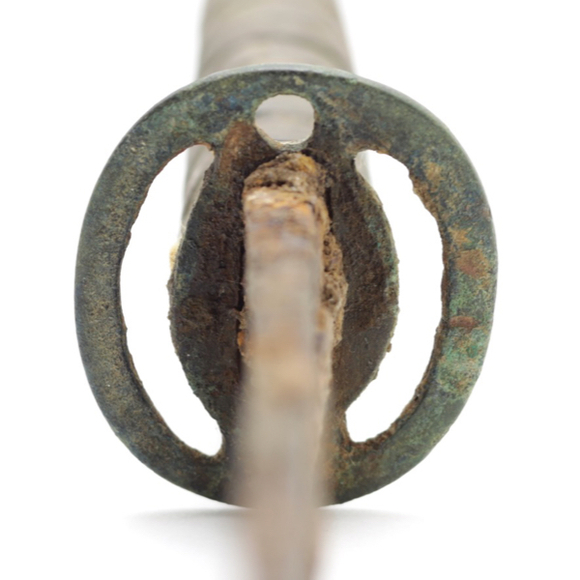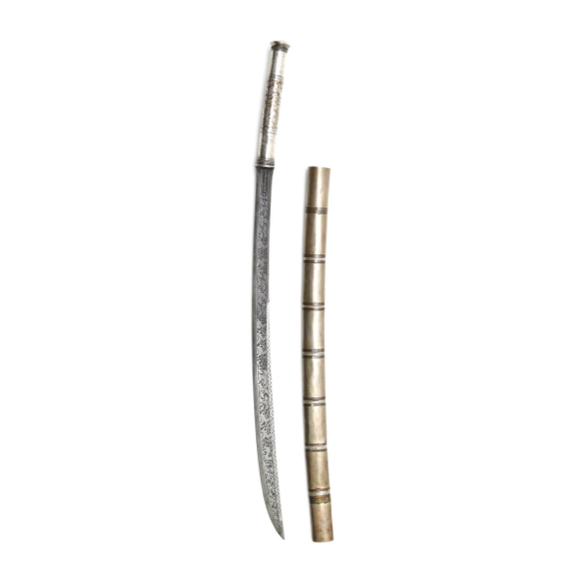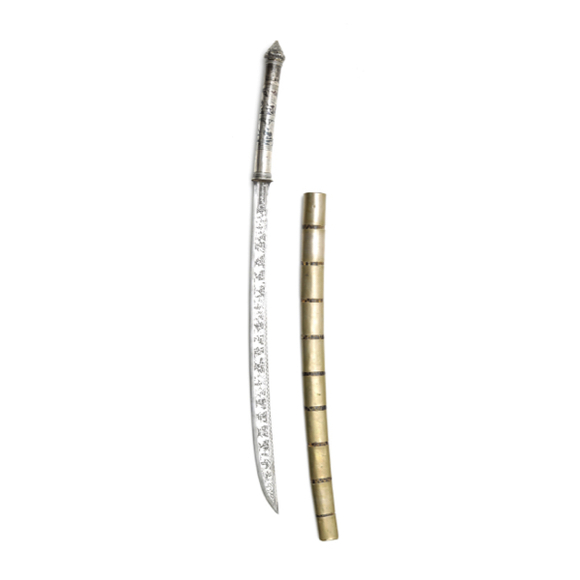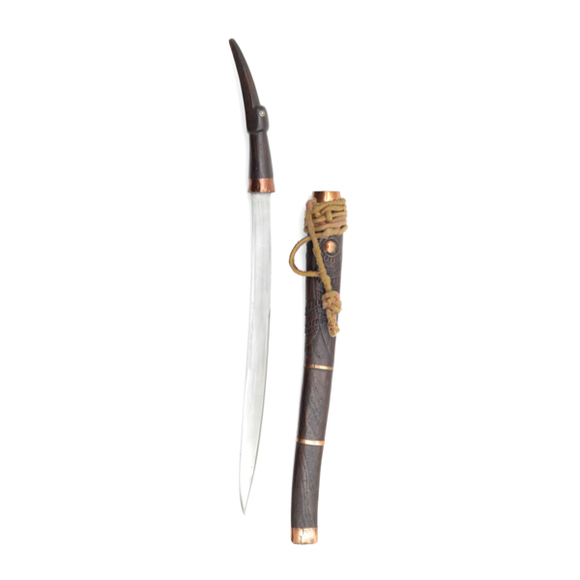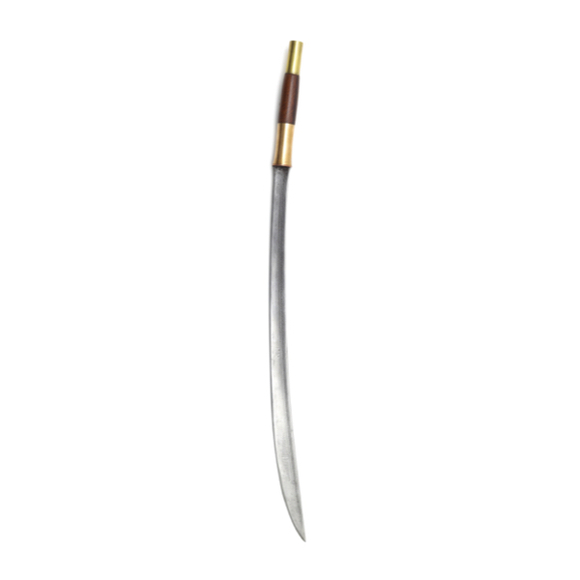In excavated condition, with copper alloy hilt.

77 cm
52.5 cm
Base 12.5 cm
Middle 7 mm
5 cm from tip 4 mm
Base 29 mm
Middle 32 mm
5 cm from tip 20 mm
711 grams
5.2 cm from guard
Iron, brass, bronze, wood.
Mainland Southeast Asia
68.3% probability
1671 AD - 1695 AD (11.4%)
1725 AD - 1779 AD (25.3%)
1798 AD - 1812 AD ( 6.6%)
1839 AD - 1845 AD ( 2.2%)
1852 AD - 1877 AD ( 8.7%)
1916 AD - 1944 AD (14.1%)
95.4% probability
1665 AD - 1711 AD (16.5%)
1717 AD - 1785 AD ((29.1%)
1794 AD - 1823 AD (10.1%)
1831 AD - 1894 AD (20.6%)
1905 AD - later (19.2%)
Introduction
This sword is of a type of which several circulate on the market, and a few are found in museums. While some are definitely genuine, a number of them seem questionable. So far most are classified as Khmer, which could refer to an ethnic group or the empire that lasted from 802 AD to 1431 AD. Few have any decorative features that allow for accurate dating.
With most, only metals remain but in this case, the hilt contained slivers of wood so I sent them for carbon dating. See the results below.
This example
The blade has a moderate curvature, bending away from the hilt at the base and then straightening somewhat, forming its broadest at the center of percussion before narrowing down to a sharp point. The blade is very thick at the base, tapering gradually towards the tip.
It has an eight-lobed disc guard, inspired by similar Japanese sword guards that made it to the region from at least the 16th century onwards.
The hilt consists of two cylindrical pieces of brass with a joint about 3/5th of its length towards the pommel. The pommel is peened over what was perhaps once a full-tang construction, if so that is unusual for dha and more in line with Chinese sword-making traditions.
Inside the hilt are slivers of wood, some fiber, a copper alloy sheet, and some more recent paper that was inserted to keep it somewhat together.
Condition
Excavated condition. Blade heavily corroded. Brass is in decent condition, with no significant losses to the hilt. See photos.
Scientific analysis
I sent the piece out for both X-ray fluorescence (XRF) and radiocarbon dating. XRF is a non-destructive method to determine the composition of a material by exposing it to high-energy gamma rays, after which it briefly emits fluorescent X-rays peculiar to each element. Older materials are not as homogenous as modern materials, so you can expect to get a slightly different reading at each spot of a single piece. Elements lighter than magnesium cannot be measured using XRF, so unfortunately it cannot detect the levels of carbon in the iron.
Radiocarbon dating determines the amount of radioactive carbon isotope 14C there is in a material. 14C is constantly created in the earth's atmosphere and absorbed by plants through photosynthesis. When the plant dies, or the animal that eats the plant stops consuming, the level of 14C in it will gradually decline. 14C levels were generally relatively stable, making fairly accurate dating possible for most periods. From the 18th century onwards, atmospheric and human activity distorted the 14C content in the atmosphere, giving a much wider range of possible dates for later pieces.
XRF results
Hilt guard side (brass)
72.7% copper
22.5% zinc
2.6% silicon
Trace elements below 1% of antimony, tin, lead, nickel, iron.
Hilt pommel side (leaded copper alloy)
72.3% copper
6.6% lead
4.5% zinc
4% aluminum
2.7% tin
8.4% silicon
Trace elements below 1% of antimony, nickel, iron, titanium, bismuth, phosphorous.
Pommel cap (copper alloy)
77.7% copper
5.1% tin
3.1% aluminum
1.7% lead
1% phosphorous
10% silicon
Trace elements below 1% of antimony, bismuth, gold, nickel, iron, titanium, manganese.
Guard (leaded copper alloy)
72.5% copper
7.1% lead
5.8% tin
4.3% aluminum
2.8% zinc
1.2% iron
5.9% silicon
Trace elements below 1% of antimony, zirconium, bismuth, nickel, manganese.
Blade
94.1% iron
1.8% aluminum
2.3% silicon
Trace elements below 1% of molybdenum, tungsten, copper, nickel, sulfur.
It is interesting to see how much the composition of the alloys differ per piece, indicating perhaps a production line where different parts came from different batches or sources. The somewhat erratic compositions are also indicative of traditional manufacture. Modern materials tend to be more homogenous in composition.
The high levels of silicon are usually indicators of a piece that has been in the ground for some time.
Radiocarbon dating
A piece of old wood deep into the guard side hilt sleeve was prepared for carbon dating. It gave the following results:
68.3% probability
1671 AD - 1695 AD (11.4%)
1725 AD - 1779 AD (25.3%)
1798 AD - 1812 AD ( 6.6%)
1839 AD - 1845 AD ( 2.2%)
1852 AD - 1877 AD ( 8.7%)
1916 AD - 1944 AD (14.1%)
95.4% probability
1665 AD - 1711 AD (16.5%)
1717 AD - 1785 AD ((29.1%)
1794 AD - 1823 AD (10.1%)
1831 AD - 1894 AD (20.6%)
1905 AD - ... (19.2%)
(OxCal v4.4.2 Bronk Ramsey, 2020. Atmospheric data from Reimer et al, 2020.)
The results are quite broad, due to the abovementioned 14C instabilities from the 18th century onwards. The piece most likely dates from the 18th century. There is one caveat, the dating is based on a sliver of wood that was lodged inside the hilt. Hilts break and their wood can be replaced at later times.
Interesting comparables
This coincides with the proposed dating of a group of swords in the History Museum, Hue, Central Vietnam, photographed by Gary Todd which are dated to the Tây Sơn dynasty of 1778–1802. These swords are not an exact match, having shorter hilts, different blade styles, but there are similarities in construction and guard styles.
Update, 23 February 2022
In conversations with collector Iain Norman he pointed out how many of these in local museums seem to be attributed to the Battle of Rạch Gầm-Xoài Mút. It was fought between the Vietnamese Tây Sơn forces and an army of Siam in present-day Tiền Giang Province in the Meikong river delta in the south of Vietnam on January 20, 1785.
On the Siamese side there were some 20.000 sailors and 30.000 infantry, using 300 warships, aided by some 3000-4000 troops of the north Vietnamese Gia Long emperor. On the Tây Sơn side were 30.000 men with 55 warships, 100 sailing boats and 300 canoes.
It resulted in a decisive Tây Sơn victory, with an estimated 40.000 killed on the Siamese side, and their entiry navy destroyed. Today, treasure hunters still dredge and dig up swords from this battle, and it seems likely that the ones on the market -including this one- can be dated back to that event.
Conclusion
I find it quite exciting to finally have some data on at least one of these. I hope the results help fellow researchers and enthusiasts in their further study of older Southeast Asian swords.
One peculiar aspect about the group of swords that this piece belongs to is that all are found in excavated condition. A question that begs for an answer is why so many of these got buried in the ground, as one would think that when not needed their raw materials still represented value.
Possible explanations are they:
-Buried them with the intent to artificially age them
-To hide them from authorities, like the Khmer Rouge in Cambodia who would have surely confiscated them
-As part of a religious rite or custom
And of course, we can't simply rule out plain neglect and/or a natural event.
I hope information will surface in time that helps narrow down the possibilities.
















Fine silver overlaid dha made in Mindan village, south of Mandalay, gained fame in the 19th…

